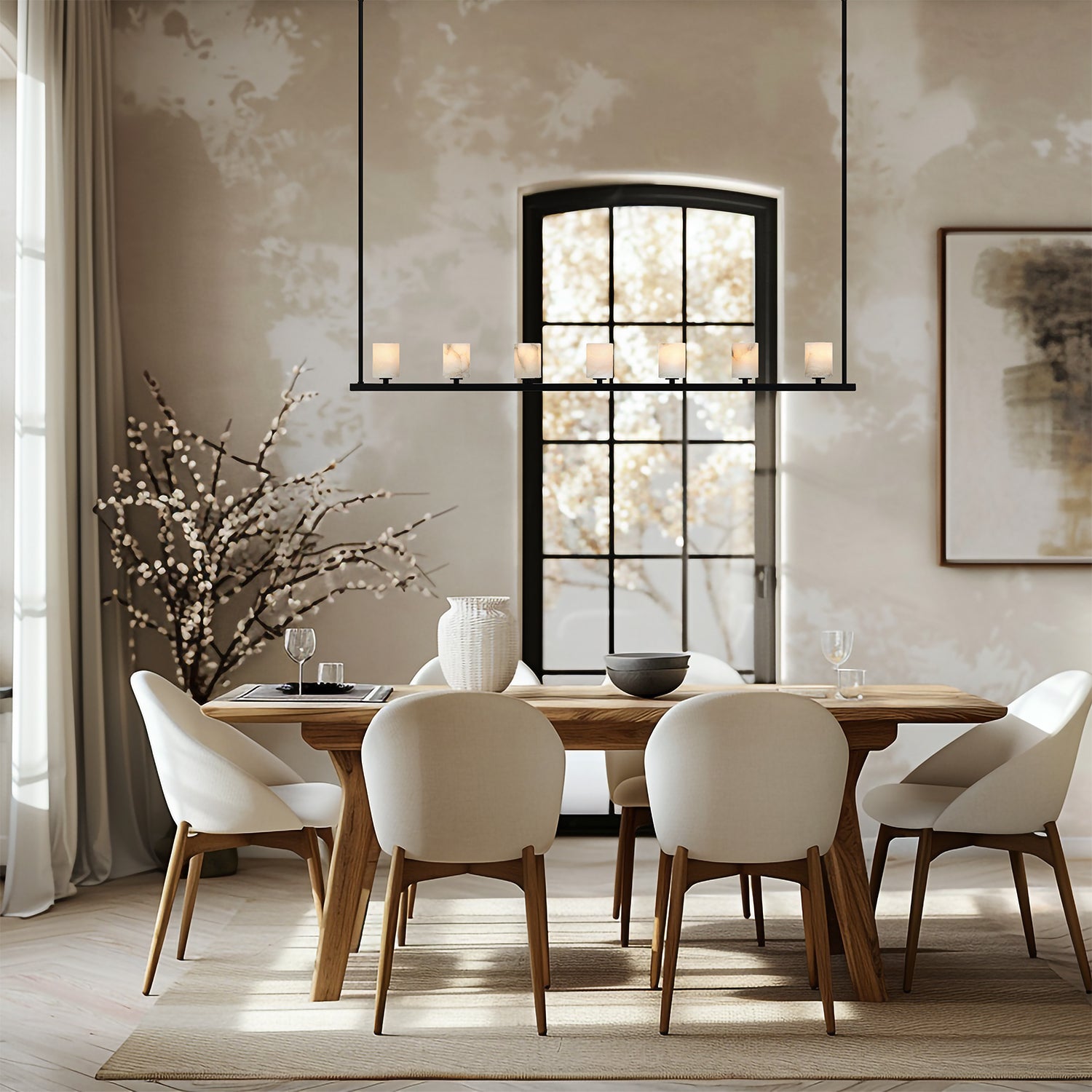On orders $99+
On orders $99+

A dining room light fixture should typically be about one-half to two-thirds the width of your dining table to ensure the fixture is proportional and visually balanced. For example, if your dining table is 48 inches wide, your light fixture should be between 24 and 32 inches in width. Additionally, consider the room size and ceiling height—larger rooms or higher ceilings can accommodate bigger, more dramatic fixtures, while smaller spaces benefit from more compact designs. Hanging height is also key: the bottom of the fixture should hang about 30 to 34 inches above the table for optimal lighting and aesthetic appeal.
Choosing the right size dining room light fixture is essential for creating a balanced and visually appealing space. The light fixture serves as both a functional element, providing ample illumination, and a key design feature that enhances the room’s overall aesthetic. Selecting a fixture that’s too large can overwhelm the space, while one that’s too small may feel underwhelming and fail to provide adequate lighting. In this guide, we’ll explore how to determine the ideal size for a dining room light fixture, considering the size of your dining table, room dimensions, and the style of the fixture.

When choosing the size of a dining room light fixture, there are several important factors to keep in mind:
The size of your dining table is one of the most important factors to consider when selecting a light fixture. A common rule of thumb is that the light fixture should be about one-half to two-thirds the width of your dining table. This ensures the fixture is large enough to make a visual impact without overpowering the table or the room.
Consideration for Multiple Fixtures: If you have an extra-long dining table or prefer multiple light sources, consider using two smaller fixtures or a row of pendant lights. In this case, the combined width of the fixtures should follow the same rule of half to two-thirds the table width, but the spacing between the fixtures becomes crucial for balance.
The size of the room also influences the size of the dining room light fixture. A larger room with more open space can accommodate a larger, more dramatic fixture, while a smaller dining room requires a more modest fixture that doesn’t crowd the space. In general, you can add the dimensions of the room (in feet) to estimate the fixture’s diameter in inches. This is a simple formula to follow:
Room Length (in feet) + Room Width (in feet) = Approximate Fixture Diameter (in inches)
This guideline ensures the fixture is proportional to the room and doesn’t feel too small or too large.
Ceiling height is another critical factor in determining the size and type of dining room light fixture. A higher ceiling allows for larger and more dramatic fixtures, such as chandeliers or multi-tiered pendants, while a lower ceiling calls for a smaller, more compact fixture.
Tip: Adjustable fixtures are a great option if you want flexibility in the hanging height, especially if you have a dimmer or adjustable dining room setup.
The style of the light fixture also affects how large it should be. Some styles, such as modern or minimalist designs, tend to look better in larger sizes because of their clean lines and simple shapes. More ornate fixtures, like traditional chandeliers with multiple arms, can feel more dominant even at smaller sizes due to their intricate details and visual weight.
Example: In a modern dining room with minimalist decor, a large 36-inch-wide pendant light with a sleek metal finish can serve as a striking focal point without feeling heavy. In contrast, a more traditional dining room might use a 24-inch-wide crystal chandelier that provides elegance without dominating the room.

Here are some practical tips to ensure you choose the best light fixture size for your dining room:
Test the Fixture Size: Before committing to a fixture, test the size by using a visual guide, such as a cardboard cutout or measuring tape, to simulate the fixture’s dimensions above your dining table. This will help you visualize how the fixture will look in the space and prevent buying a fixture that’s too big or too small.
Balance the Room: Consider the other furniture and decor in the room when selecting a fixture. If you have a large dining table, matching oversized chairs, or bold artwork, make sure the light fixture complements these elements without competing for attention.
Consider Lighting Needs: Don’t just focus on the size—make sure the fixture provides enough light for the space. If your chosen fixture is more decorative than functional, you may need additional lighting, such as recessed lights or wall sconces, to ensure the room is well-lit.
Multiple Light Fixtures: If your dining table is particularly long or you want to add more visual interest, consider using two or more smaller fixtures. For example, a series of pendant lights or a pair of chandeliers can provide balanced lighting while creating a stylish, modern look.

When choosing the right size light fixture for your dining room, the goal is to strike a balance between form and function. A well-sized light fixture should complement your dining table, room dimensions, and overall design aesthetic, while also providing ample lighting for dining and entertaining. By considering factors like table size, room dimensions, ceiling height, and fixture style, you can confidently choose a light fixture that enhances both the practicality and beauty of your dining space. Whether you opt for a bold, oversized chandelier or a series of sleek, modern pendants, selecting the right size fixture ensures your dining room is both well-lit and visually harmonious.
Helpful Links:
Explore our Designer Selection of Dining Room Lighting Fixtures
Selecting the Ideal Lighting for Your Dining Room
Chandelier vs. Pendant Light: Understanding the Key Differences
Leave a comment